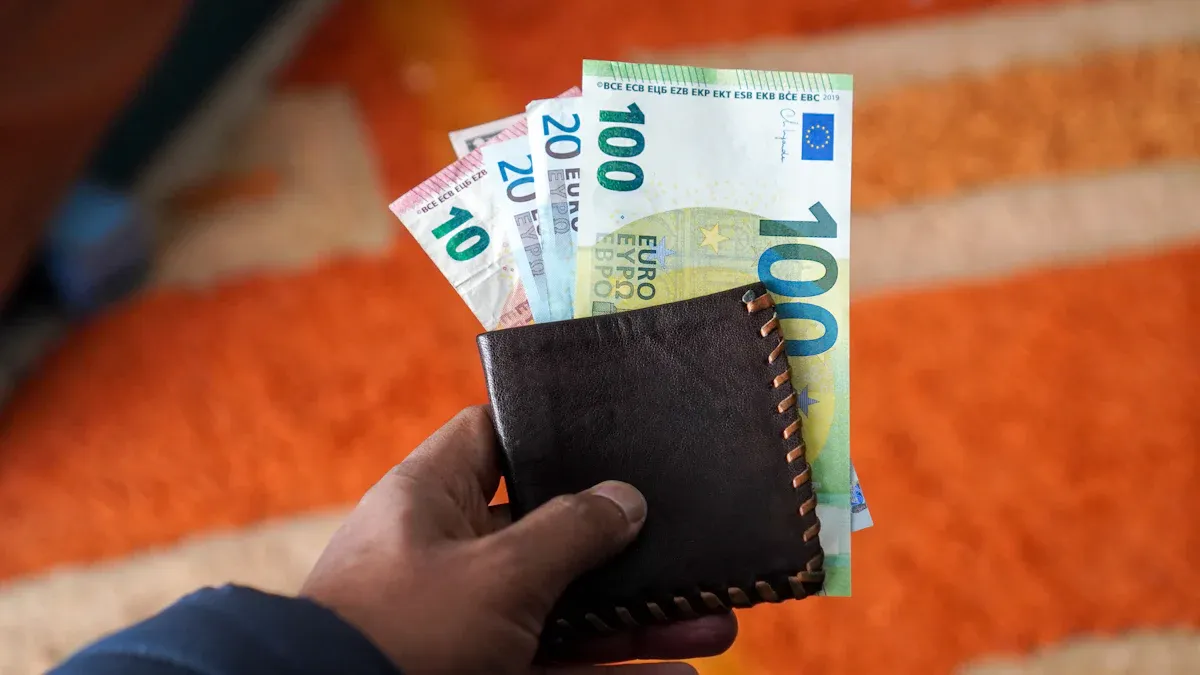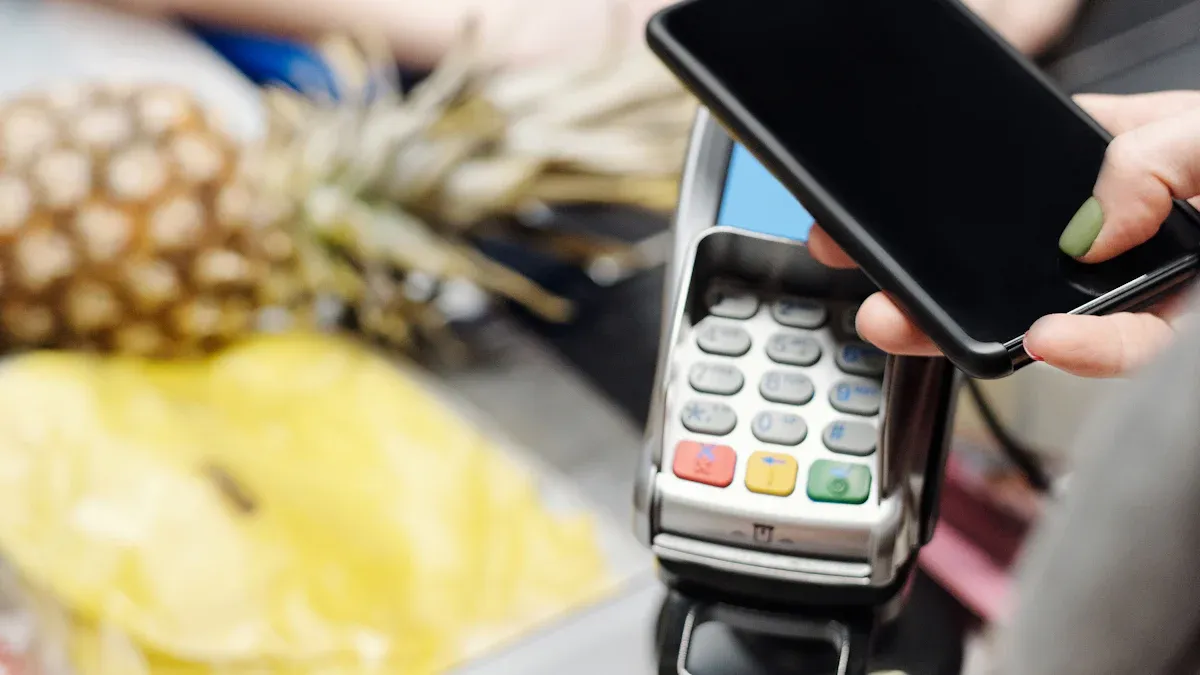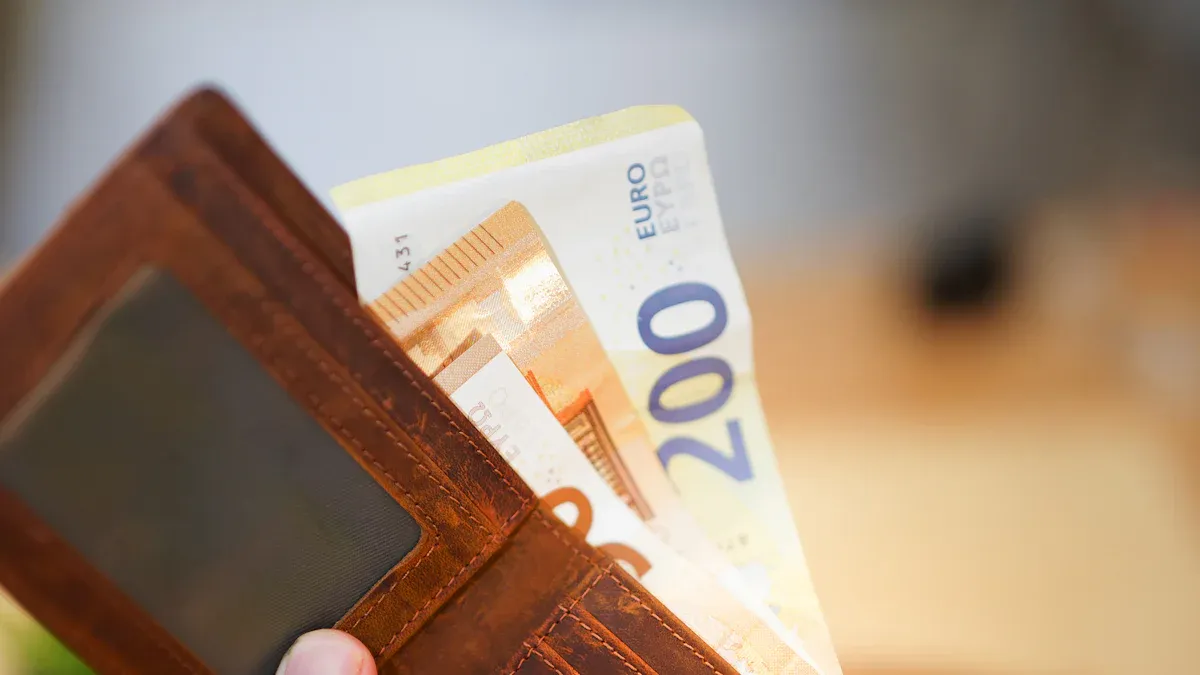- EasyCard
- Trade
- Help
- Announcement
- Academy
- SWIFT Code
- Iban Number
- Referral
- Customer Service
- Blog
- Creator
Do You Need Cash When Traveling in Spain? Understand the Use of Credit Cards and Withdrawal Limits

Image Source: unsplash
Ready to start your trip to Spain? First, make one thing clear: credit cards are your primary payment tool in Spain, but a small amount of cash is equally essential.
This payment guide will provide you with clear advice. It will help you easily handle various payment scenarios, allowing you to enjoy every moment of your journey with peace of mind.
Key Points
- In Spain, credit cards are the main payment method, with cash as an important supplement.
- When paying by card, choose to settle in euros to avoid unnecessary exchange rate losses.
- Prepare 50 to 100 euros in cash for tips, small shop purchases, and emergencies.
- Before departure, contact your bank to confirm overseas withdrawal fees and limits.
Overview of Payment Methods for Travel in Spain
In Spain, your payment strategy can be very simple. Think of it as a combination: credit cards are the star, and cash is an important supporting role. Understanding the division of labor between the two will make your trip smoother.
Our core strategy can be summarized as:
| Payment Method | Role Positioning | Key Points |
|---|---|---|
| Credit Card | Primary Payment Tool | Used for most purchases, safe and convenient |
| Cash (Euros) | Necessary Supplement | Used for small payments, specific scenarios, and emergencies |
This “credit card primary, cash secondary” model is the most practical and efficient payment method for you in Spain.
Credit Cards: The Preferred Payment Method
Credit cards are your key to unlocking a trip to Spain. From booking hotels, enjoying meals at restaurants, to buying attraction tickets and shopping at large supermarkets, card payments are seamless. Their convenience and security make them the top choice for large purchases and daily main expenses.
In Spain, the vast majority of merchants accept credit cards. You need to ensure you carry Visa or Mastercard, as these two cards have the widest acceptance and are available almost everywhere. In comparison, American Express has a smaller acceptance range. Using a credit card allows you to avoid the risk of carrying large amounts of cash, making your finances safer.
Cash: Necessary Supplement
Although card payments are very convenient, not bringing any cash at all will cause some minor troubles during your trip to Spain. Cash still plays an indispensable role in certain specific situations.
According to a 2023 report by the Bank of Spain (Banco de España), cash remains very common in daily small transactions, with about 65% of people using it for daily payments. This means that when visiting local markets, buying water at street-side shops, or dining at some cash-only small restaurants, euro coins and banknotes are your pass.
Core Advice: Use credit cards as your primary payment tool while preparing a small amount of euro cash. This way, no matter what payment scenario you encounter, you can handle it with ease.
Credit Cards and Mobile Payments

Image Source: pexels
In Spain, credit cards and mobile payments are powerful assistants for modern travelers. Understanding their usage range and tips can make your payment experience smooth as silk.
Widely Accepted Locations
You can confidently use credit cards in most places in Spain. Visa and Mastercard have the widest acceptance, available almost everywhere.
The following locations generally welcome card payments:
- Hotels and Accommodations: All hotels and official apartments.
- Large Chain Supermarkets: Such as Mercadona, Carrefour, El Corte Inglés.
- Restaurants and Cafes: The vast majority of restaurants are equipped with mobile POS machines, and waiters will settle the bill directly at your table.
- Major Tourist Attractions: Museum and historical site tickets.
- Transportation Hubs: Train stations, airports, long-distance bus stations.
- Brand Retail Stores: Clothing, cosmetics, and electronics stores.
According to Spanish law, when the purchase amount exceeds 30 euros, merchants must provide you with the option to pay by card. This means your rights are protected for larger purchases. However, American Express has relatively lower acceptance, so it’s recommended to use it as a backup card.
Scenarios Where Use May Be Limited
Although card payments are convenient, you may encounter restrictions in certain situations. Knowing these scenarios in advance can avoid unnecessary embarrassment.
- Small Family Shops and Newsstands: These places may only accept cash or have a minimum spend requirement. For example, shops may require a minimum of 5 or 10 euros to allow card payments.
- Local Markets (Mercado): When visiting local markets, you’ll find many small stalls, especially those selling fresh produce and handicrafts, prefer cash transactions.
- Remote Rural Towns: In areas far from big cities, cash is king. Some small restaurants or shops may not have POS machines installed.
- Some Taxis: This is a gray area. In theory, taxis in big cities like Madrid and Barcelona should accept credit cards. But in reality, you may encounter drivers claiming the POS machine is “broken” because they prefer cash. The safest approach is: show your credit card to the driver before getting in and ask if they accept it.
Popularity of Mobile Payments
Contactless payments are becoming increasingly popular in Spain. If you’re used to using Apple Pay or Google Pay, you’ll feel very convenient when traveling in Spain. As long as you see the contactless payment symbol (a Wi-Fi-like signal) on the POS machine, you can pay directly with your phone or smartwatch.
Digital wallets occupy an important position in Spain’s payment market.
| Payment Method | Expected Market Share |
|---|---|
| Credit/Debit Cards | ~51–62% |
| Digital Wallets (including Apple/Google Pay) | ~26% |
| Bizum (local instant transfer) | ~15–25% |
This indicates that nearly a quarter of transactions are completed through digital wallets. However, note that this convenience is mainly concentrated in cities and among young people. In rural areas or with older shop owners, they still prefer traditional cash payments.
Payment Currency Selection Tips
This is the most important tip when using a credit card in Spain, which can save you a lot of money. When you swipe your card at a POS machine, the screen may show two options:
- Settle in your home currency (e.g., CNY, USD)
- Settle in local currency (EUR)
Always choose to settle in euros (EUR)!
If you choose to settle in your home currency, it will trigger a mechanism called “Dynamic Currency Conversion, DCC”. This allows the merchant and its partner financial institutions to use an exchange rate that is very unfavorable to you, usually 3%-5% higher than the bank’s real-time rate. This extra cost is completely avoidable. So, remember this simple principle: in the eurozone, always settle in euros.
ATM Withdrawal Essentials
Although credit cards are convenient, there will always be times during your trip to Spain when you need cash. Withdrawing at an ATM is the most direct way to get euros, but you need to understand the related fees and limits to withdraw more smartly.
Fee Structure
When using an ATM in Spain, fees usually consist of three parts. Understanding these can help you make more economical choices.
Withdrawal Fee = Spanish Local Bank Fee + Your Issuing Bank Fee
- Spanish Local Bank ATM Usage Fee: This is the fee charged by Spanish banks for using their ATMs with foreign bank cards. This fee will be displayed on the screen before you confirm the withdrawal, usually between 2 and 5 euros per transaction.
- Your Issuing Bank Overseas Withdrawal Fee: This is the service fee charged by your bank (e.g., a debit card issued by a bank in Hong Kong). It’s best to consult your bank for specific rates before departure.
- Possible Currency Conversion Spread: If you choose to settle in your home currency at the ATM, it will also trigger DCC (Dynamic Currency Conversion), leading to exchange rate losses. Always choose to withdraw in euros (EUR).
To reduce costs, it’s recommended to use a debit card rather than a credit card for cash withdrawals, as credit card cash advances usually incur higher fees and interest.
Reference ATM usage fees for some major banks are as follows:
| Bank Name | ATM Usage Fee (Foreign Card) | Notes |
|---|---|---|
| CaixaBank | Approx. 5 euros | Relatively high fee. |
| BBVA | May be free | User feedback varies, but recent reports indicate free for foreign cards. |
| Santander | May be free | Similar to BBVA, some users report free withdrawals. |
| Other Banks | Approx. 1.5-3 euros | Many other banks have more reasonable fees. |
Withdrawal Limits
How much you can withdraw at an ATM is subject to two restrictions:
- Spanish ATM Single Transaction Limit: Most Spanish bank ATMs have a single withdrawal limit usually between 300 and 600 euros.
- Your Issuing Bank Daily Limit: Your bank card itself also has a daily overseas withdrawal maximum. Although Spanish banks may have a daily withdrawal limit for customers up to 3,000 euros, the final decision lies with your issuing bank.
Important Reminder: Before departure, be sure to contact your issuing bank to confirm whether your card has overseas withdrawal enabled and to understand the daily withdrawal limit and related fees.
ATM Distribution
Finding an ATM in Spain is very easy. Whether in big cities like Madrid and Barcelona or small towns in Andalusia, you can find them at bank branches, shopping centers, airports, and main streets. They are usually marked with “Telebanco” or “ServiRed” network identifiers. However, in remote rural areas, the number of ATMs decreases significantly, so preparing cash in advance is safer.
Where Cash Comes in Handy

Image Source: unsplash
Although credit cards and mobile payments are powerful, cash (euros) still plays an indispensable role in your trip to Spain. Understanding these “uses for cash” can help you avoid many small troubles and experience local life more deeply.
Small Purchases and Markets
When strolling through the streets of Spain, you’ll be attracted by various specialty shops and lively markets. In these places, cash is your best friend.
- Local Markets and Small Stalls: When visiting local markets (Mercado), you’ll see many stalls selling fresh fruits, handicrafts, or local specialties. Most of these small vendors only accept cash.
- Street-Side Shops and Newsstands: Want to buy a bottle of water, a newspaper, or a postcard? These places usually only accept cash or have a minimum card spend (e.g., 5 or 10 euros).
- Specialty Souvenirs: You might discover beautiful candles for just 4 euros at Barcelona’s century-old Cereria Subirà or specialty perfumes under 12 euros at Álvarez Gómez. These charming small items are more convenient to pay for with cash.
Many famous pastry shops, although they may accept cards, paying for a few euros’ worth of pastries with cash is quicker. For example, in Madrid’s famous shops, a dessert purchase usually ranges from 5 to 25 euros, perfect for using cash.
- Horno de San Onofre
- El Riojano
- Moulin Chocolat
Tipping
In Spain, tipping culture is subtle. It’s not mandatory, but expressing gratitude is polite. Paying tips in cash is the best way to ensure your appreciation reaches the service staff directly.
Core Tip: Pay tips in cash. Although some places allow adding tips to credit cards, this money may not reach the waiter directly. For example, in Ronda, waiters do not receive tips added to credit cards.
Here’s a simple tipping guide for your reference:
| Scenario | Tipping Suggestion | Key Points |
|---|---|---|
| Restaurants/Cafes | 5%-10% of the bill | Only give if service is good. Check if the bill already includes service charge (servicio incluido or IVA). |
| Hotel Services | 1-2 euros per time or per night | Give to porters who carry your luggage or room cleaners. |
| Guides/Drivers | 2-10 euros per person | Based on service duration and quality. Private tours or full-day tours can tip more. |
When you hand cash to the waiter and say “Gracias” (thank you), it usually means you don’t need change. This is an authentic and friendly way to express yourself.
Some Public Transportation
Although automatic ticket machines at metro stations in major Spanish cities generally accept credit cards, cash is particularly important when taking buses.
Special Note: Some bus lines in Madrid may only accept cash or transit card payments.
Even in cities that accept bank cards, you may encounter issues:
- Barcelona: Bus drivers usually do not accept banknotes over 5 euros. You need to prepare exact change.
- Seville: Bus drivers do not accept banknotes over 10 euros, and after 9 PM, they may not provide change at all.
Therefore, keeping some coins and small-denomination banknotes in your pocket is a wise move to ensure you can board buses smoothly.
Cash Payment Limits
To combat tax fraud, Spanish law sets a limit on cash transactions. Understanding this regulation can give you peace of mind when making large purchases.
According to the anti-fraud law passed in 2021 (Law 11/2021), the limit for single cash transactions between Spanish residents is 1,000 euros.
Good News for Tourists: This regulation has an exemption for non-Spanish tax residents like you.
If you are not a Spanish tax resident (e.g., as a tourist), your cash payment limit increases to 10,000 euros. This means if you want to buy luxury goods or other expensive items with cash, as long as the amount is within 10,000 euros and you can prove your tourist status (e.g., by showing your passport), it is completely legal.
Emergency Backup Funds
Our Recommendation: Carry 50-100 euros in cash as emergency backup funds.
This amount isn’t much, but it’s enough to let you eat a meal, take a taxi, or buy essentials when electronic payment systems fail. Keep it in a safe place, hoping you never need it, but it will give you peace of mind.
To ensure worry-free payments on your trip to Spain, remember these four core recommendations:
- Primarily Use Credit Cards: Mainly use Visa or Mastercard credit cards. Contactless payments are also common, making large purchases safe and convenient.
- Choose Euro Settlement: When swiping your card, always choose to settle in euros (EUR). This helps you avoid unnecessary exchange rate losses.
- Prepare a Small Amount of Cash: Prepare 50-100 euros in cash. It’s very useful for tipping, taking some buses, or shopping at small markets.
- Consult Your Bank: Before departure, confirm overseas withdrawal fees with your bank. Although some banks no longer require travel notifications, confirming in advance always gives you more peace of mind.
Wishing you a trip to Spain filled with sunshine and wonderful memories!
FAQ
Can I use UnionPay cards in Spain?
UnionPay cards have limited acceptance in Spain. You can withdraw cash at some ATMs that support UnionPay, but in shops and restaurants, Visa and Mastercard are still the mainstream. It’s recommended to use UnionPay as a backup card, not the primary payment tool.
How many euros in cash should I exchange?
Recommended Amount: 50-100 euros
This amount is enough to handle scenarios where cards cannot be used, such as tipping, taking some buses, or shopping at small markets. For large purchases, prioritize credit cards for greater safety.
What if a merchant refuses to accept my credit card?
First, politely ask for the reason; sometimes it’s just a network or machine issue. If the merchant insists on cash only (especially for small purchases), your prepared backup cash will come in handy.
Do I need to notify my bank before departure?
Yes, it’s strongly recommended. Notifying your bank of your travel plans in advance can effectively prevent your card from being frozen due to being flagged as suspicious transactions. You can also take this opportunity to confirm overseas transaction fees again.
*This article is provided for general information purposes and does not constitute legal, tax or other professional advice from BiyaPay or its subsidiaries and its affiliates, and it is not intended as a substitute for obtaining advice from a financial advisor or any other professional.
We make no representations, warranties or warranties, express or implied, as to the accuracy, completeness or timeliness of the contents of this publication.




Contact Us
Company and Team
BiyaPay Products
Customer Services
is a broker-dealer registered with the U.S. Securities and Exchange Commission (SEC) (No.: 802-127417), member of the Financial Industry Regulatory Authority (FINRA) (CRD: 325027), member of the Securities Investor Protection Corporation (SIPC), and regulated by FINRA and SEC.
registered with the US Financial Crimes Enforcement Network (FinCEN), as a Money Services Business (MSB), registration number: 31000218637349, and regulated by FinCEN.
registered as Financial Service Provider (FSP number: FSP1007221) in New Zealand, and is a member of the Financial Dispute Resolution Scheme, a New Zealand independent dispute resolution service provider.


















